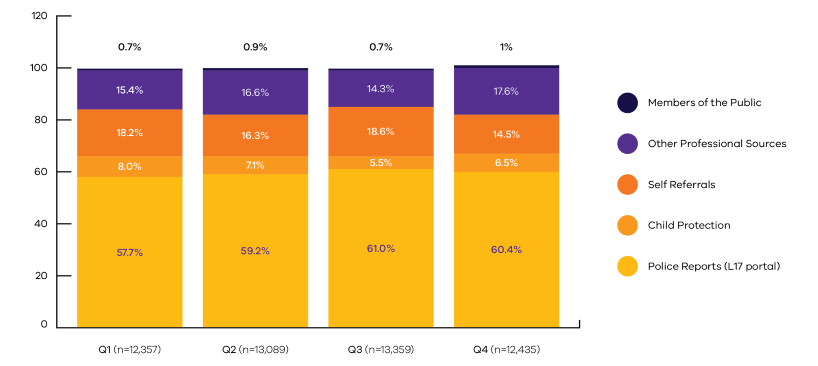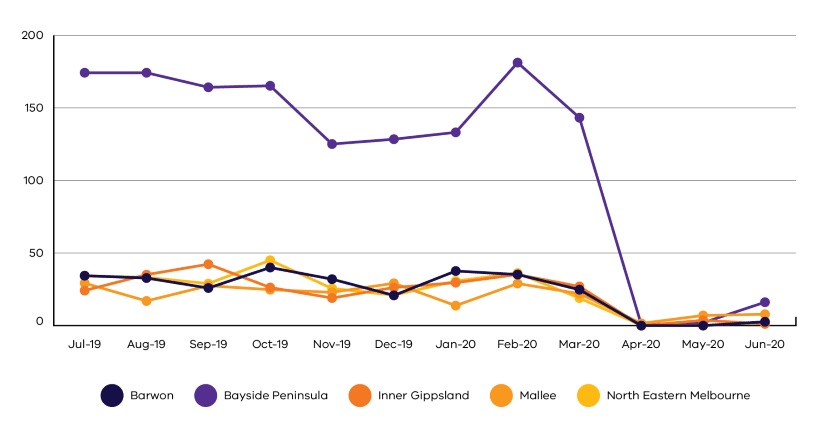The Orange Door brings together safe referral points for victims and perpetrators of family violence and children and families needing support. It plays a unique role in coordinating streamlined service provision for individuals and families within the broader service system.
Accessing The Orange Door
How are people accessing The Orange Door for assistance?
In the 2019-20 financial year, The Orange Door received 51,240 referrals, a 24.1% increase from the previous year. A large majority (72.6%) of the increase in referrals was in Q1 and Q2, which may indicate increased community and referrer awareness of The Orange Door. The slowdown in referrals in the second half of the year is likely due the impact of coronavirus restrictions during Q4.
A referral can either be for an individual or a group such as a family. Figure 2 shows the number of referrals received for each quarter, and the different access pathways into The Orange Door network.
In instances where families are referred to The Orange Door, practitioners consider the needs of each individual family member separately. As such, the number of individuals The Orange Door works with is greater than the number of referrals received.
In 2019-20, 59,592 people were identified as potentially requiring support from The Orange Door – this could include support with identification of key issues and safety risks to being provided with an immediate crisis response or connected to services. Practitioners will attempt to make contact with people identified and referred in order to offer a service in almost all instances.[2]
Referrals that come directly from Victoria Police when there has been a report of an incident of family violence (known as ‘L17s’) are provided through a dedicated online portal (the L17 portal). In 2019-20, the most common way people accessed The Orange Door network was through police referral reports, making up 59.6% of all referrals. This proportion has remained relatively steady since commencement of The Orange Door in all areas.
People do not need a professional referral to access The Orange Door. Individuals and families who need support from The Orange Door can make a ‘self-referral’, meaning that they make direct contact themselves. Alternatively, referrals of individuals and families can be made by a range of professionals or members of the community. Referrals are made to The Orange Door where someone is at risk of experiencing or has experienced family violence, or when there is concern about a child’s safety or wellbeing. Referrals can also be made for perpetrators of family violence. Professionals and members of the community can also contact The Orange Door for information and advice where there are concerns for the safety and/or wellbeing of an adult or child.
The Orange Door recognises the agency of individuals and families. In some cases, people choose not to engage with The Orange Door, or cannot be contacted, including for risk assessment purposes.
Mary’s story: facilitating multiple service responses and ensuring safety
The Orange Door is designed to be accessible to anyone, and for some people access might be more than once as their circumstances, or those of their family can change.
Over the past fifteen years, Mary* and Bob* have at times been in a relationship. Last year, following family violence, Mary and Bob separated, and Bob began residing in a small country town 100km away from Mary. Mary was pregnant at the time and was supported with a safety plan.
However, earlier this year another police report was received by The Orange Door, following an incident where Bob was threatening Mary while she was at a hospital appointment with their child.
Upon receiving the report, the practitioners in The Orange Door tried to call Mary, but she wasn’t answering the phone. To find out more about whether she and her child were at risk, the practitioners contacted other services that have worked with Bob, Mary and their one-year-old child. This gathering of risk-related information from Maternal and Child Health services, Police, Courts and Mental Health services was able to occur, because of the recently introduced Family Violence Information Sharing and Child Information Sharing Schemes. This newly introduced legislation meant that The Orange Door practitioner was able to find out that Bob had recently returned to living near Mary, and that he has continued to make threats of self-harm as well as blame Mary for recent family violence incidents.
With this information, the practitioners in The Orange Door were able to safely plan to visit Mary at her home – and in doing so, were able to better assess and understand the safety and wellbeing of her and her infant. while Mary declined the offer of a range of services and supports, the practitioners were able to work with Mary to ensure she had a safety plan that meant she felt safe in her home and had the contacts and supports for herself and her child when she felt she needed them.
*Not their real names
Figure 2. Access pathways into The Orange Door
The percentage of referrals in which individuals and families directly accessed The Orange Door for assistance through a self-referral fluctuated between 16.3% and 18.6% in Q1, Q2 and Q3 (Figure 2). These self-referrals include contact via phone, email, or walk-in. A slight decrease was noted in Q4, which coincided with COVID-19 restrictions, with stay at home directions and the closure of The Orange Door reception from late March 2020 reducing access to traditional means of support and making it more difficult for some victims of family violence to reach out
How does the community presence of The Orange Door support safe and easy access?
People can contact The Orange Door in ways that are safe, accessible, and convenient for them, including through telephone, email, and in person. The Orange Door network is designed to be a safe and accessible community service, to reduce stigma and make it easier for people seeking help for family violence or help with the wellbeing of children and families.
Most people (70%) who make direct contact for themselves, do so via telephone, as do people making contact on behalf of someone they know (86%), while more than 70% of all professional referrals are received via email (excluding the Family Violence reports from police which are all transmitted via the L17 portal). Each area has a toll-free telephone number and direct email address to facilitate easy contact. The Orange Door website has a service finder to support people to find the contact details for The Orange Door in their area, or relevant services in areas where The Orange Door is yet to be established. The website is accessible in 51 different languages. In 2019-20 the website was viewed more than 130,000 times by more than 83,000 people.
Figure 3: Ways of contacting The Orange Door (other than police reports)
The physical premises of The Orange Door have been established in locations near local communities central to community service providers and public transport. The number of times individuals or families accessed the communitybased premises fluctuated across the first three quarters of the second year of service delivery and decreased sharply during the COVID-19 period. From March 2020 The Orange Door reception moved to remote delivery and the ability for people to directly access the service through the primary premises through an unplanned visit was suspended (Figure 4). Planned face to face appointments at The Orange Door were made available for people assessed as high risk or with high support needs and people were still able to access The Orange Door via email and phone during that time.
Figure 4. Number of times individuals or families accessed the primary premises at point of referral
In 2019-20, a total of 2,473 individuals and families (4.8%) presented to The Orange Door in person looking for support for themselves or someone else. This was a 62.4% increase compared to 2018-19, which suggests increasing awareness about The Orange Door in the community
[2] In some instances, practitioners may determine not to attempt contact with a person referred where there is potential this may increase risk to them or another person.
Updated


